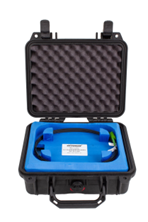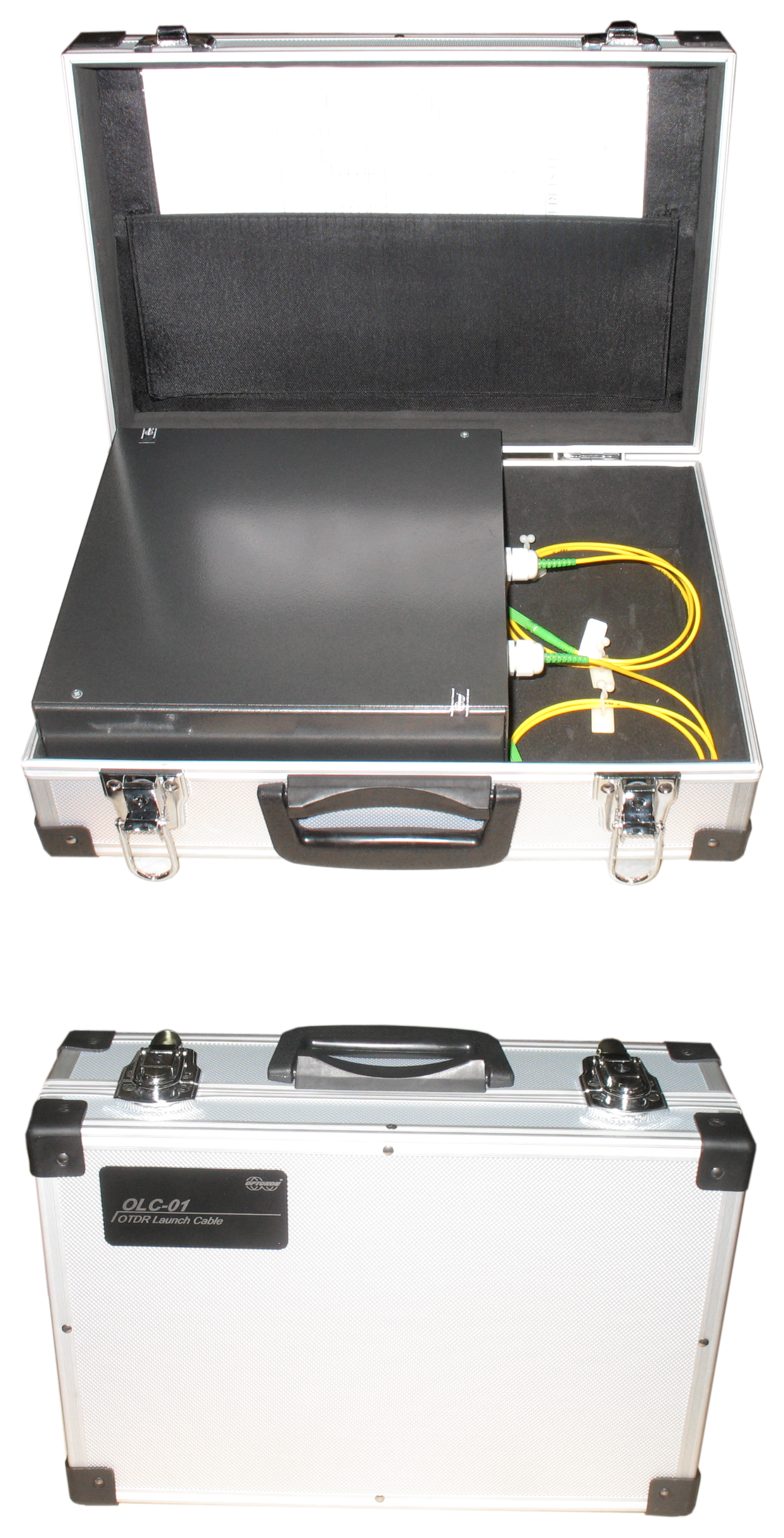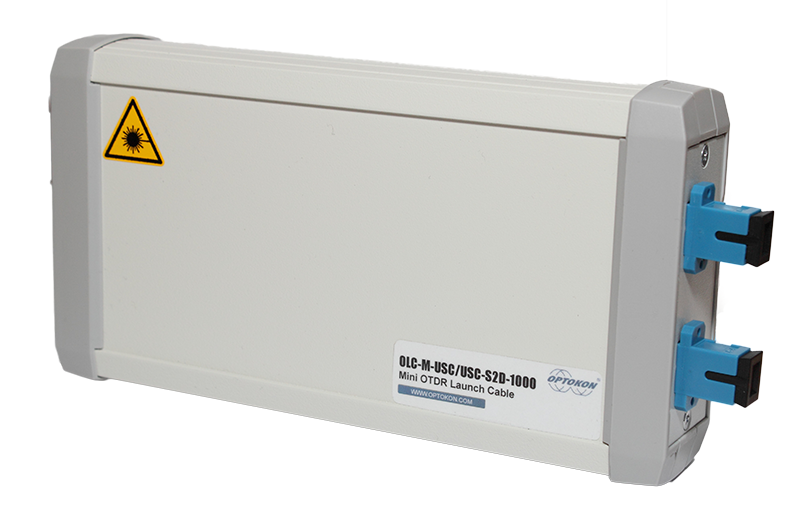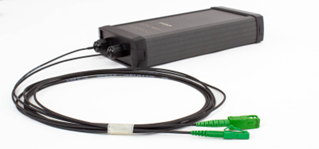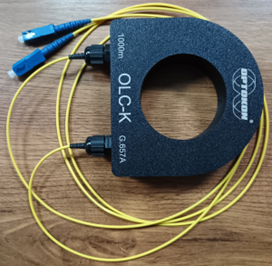OLC – PE OTDR Launch Cable
If you are installing an outside plant network such as a long-distance network or a long campus LAN with splices between cables, you will want an OTDR to check if the fibers and splices are good. The OTDR can see the splice after it is made and confirm its performance. It can also find stress problems in the cables caused by improper handling during installation. If you are doing restoration after a cable cut, the OTDR will help find the location of the cut and help confirm the quality of temporary and permanent splices to restore operation. On single mode fibers where
connector reflections are a concern, the OTDR will pinpoint bad connectors easily.
Since so little light comes back to the OTDR for analysis, the OTDR receiver circuit must be very sensitive. That means that big reflections, which may be one percent of the outgoing signal, will saturate or overload the receiver. Once saturated, the receiver requires some time to recover; until it does, the trace is unreliable for measurement.
The most common place you see this as a problem is caused by the connector on the OTDR itself. The reflection causes an overload which can take the equivalent of 50 meters to one kilometer to recover fully, depending on the OTDR design, wavelength and magnitude of the reflection. It is usually called the "Dead Zone". For this reason, most OTDR manuals suggest using a "pulse suppresser" cable, which doesn't suppress pulses but simply gives the OTDR time to recuperate before you start looking at the fiber in the cable plant you want to test. They should be called "launch" cables.
Do not ever use an OTDR without this launch cable! You always want to see the beginning of the cable plant and you cannot do it without a launch cable. It allows the OTDR to settle down properly and gives you a chance to see the condition of the initial connector on the cable plant. It should be long, at least 500 to 1000 meters to be safe, and the connectors on it should be the best possible to reduce reflections. They must also match the connectors being tested if they use any special polish techniques.
OLC - 01 OTDR Launch Cable
If you are installing an outside plant network such as a long distance network or a long campus LAN with splices between cables, you will want an OTDR to check if the fibers and splices are good. The OTDR can see the splice after it is made and confirm it's performance. It can also find stress problems in the cables caused by improper handling during installation. If you are doing restoration after a cable cut, the OTDR will help find the location of cut and help confirm the quality of temporary and permanent splices to restore operation. On singlemode fibers where connector reflections are a concern, the OTDR will pinpoint bad connectors easily.
Since so little of the light comes back to the OTDR for analysis, the OTDR receiver circuit must be very sensitive. That means that big reflections, which may be one percent of the outgoing signal, will saturate the receiver, or overload it. Once saturated, the receiver requires some time to recover, and until it does, the trace is unreliable for measurement.
The most common place you see this as a problem is caused by the connector on the OTDR itself. The reflection causes an overload which can take the equivalent of 50 meters to one kilometer to recover fully, depending on the OTDR design, wavelength and magnitude of the reflection. It is usually called the "Dead Zone". For this reason, most OTDR manuals suggest using a "pulse suppresser" cable, which doesn't suppress pulses, but simply gives the OTDR time to recuperate before you start looking at the fiber in the cable plant you want to test. They should be called "launch" cables.
Do not ever use an OTDR without this launch cable! You always want to see the beginning of the cable plant and you cannot do it without a launch cable. It allows the OTDR to settle down properly and gives you a chance to see the condition of the initial connector on the cable plant. It should be long, at least 500 to 1000 meters to be safe, and the connectors on it should be the best possible to reduce reflections. They must also match the connectors being tested, if they use any special polish techniques.
OLC - D OTDR Launch Cable
If you are installing an outside plant network such as a long distance network or a long campus LAN with splices between cables, you will want an OTDR to check if the fibers and splices are good. The OTDR can see the splice after it is made and confirm its performance. It can also find stress problems in the cables caused by improper handling during installation. If you are doing restoration after a cable cut, the OTDR will help find the location of cut and help confirm the quality of temporary and permanent splices to restore operation. On singlemode fibers where connector reflections are a concern, the OTDR will pinpoint bad connectors easily.
Since so little of the light comes back to the OTDR for analysis, the OTDR receiver circuit must be very sensitive. That means that big reflections, which may be one percent of the outgoing signal, will saturate the receiver, or overload it. Once saturated, the receiver requires some time to recover, and until it does, the trace is unreliable for measurement.
The most common place you see this as a problem is caused by the connector on the OTDR itself. The reflection causes an overload which can take the equivalent of 50 meters to one kilometer to recover fully, depending on the OTDR design, wavelength and magnitude of the reflection. It is usually called the "Dead Zone". For this reason, most OTDR manuals suggest using a "pulse suppresser" cable, which doesn't suppress pulses, but simply gives the OTDR time to recuperate before you start looking at the fiber in the cable plant you want to test. They should be called "launch" cables.
Do not ever use an OTDR without this launch cable! You always want to see the beginning of the cable plant and you cannot do it without a launch cable. It allows the OTDR to settle down properly and gives you a chance to see the condition of the initial connector on the cable plant. It should be long, at least 500 to 6000 meters to be safe, and the connectors on it should be the best possible to reduce reflections. They must also match the connectors being tested, if they use any special polish techniques.
OLC - M Mini OTDR Launch Cable
If you are installing an outside plant network such as a long distance network or a long campus LAN with splices between cables, you will want an OTDR to check if the fibers and splices are good. The OTDR can see the splice after it is made and confirm its performance. It can also find stress problems in the cables caused by improper handling during installation. If you are doing restoration after a cable cut, the OTDR will help find the location of cut and help confirm the quality of temporary and permanent splices to restore operation. On singlemode fibers where connector reflections are a concern, the OTDR will pinpoint bad connectors easily.
Since so little of the light comes back to the OTDR for analysis, the OTDR receiver circuit must be very sensitive. That means that big reflections, which may be one percent of the outgoing signal, will saturate the receiver, or overload it. Once saturated, the receiver requires some time to recover, and until it does, the trace is unreliable for measurement.
The most common place you see this as a problem is caused by the connector on the OTDR itself. The reflection causes an overload which can take the equivalent of 50 meters to one kilometer to recover fully, depending on the OTDR design, wavelength and magnitude of the reflection. It is usually called the "Dead Zone". For this reason, most OTDR manuals suggest using a "pulse suppresser" cable, which doesn't suppress pulses, but simply gives the OTDR time to recuperate before you start looking at the fiber in the cable plant you want to test. They should be called "launch" cables.
Do not ever use an OTDR without this launch cable! You always want to see the beginning of the cable plant and you cannot do it without a launch cable. It allows the OTDR to settle down properly and gives you a chance to see the condition of the initial connector on the cable plant. It should be long, at least 500 to 1000 meters to be safe, and the connectors on it should be the best possible to reduce reflections. They must also match the connectors being tested, if they use any special polish techniques. The OLC-M, compact pocket size OTDR launch cable is designed for easy handling and carrying. Its robust design ensures reliability and endurance. Protective caps helps keeping connectors clean. This launch cable is fully compatible with almost all OTDRs. Specially with OPTOKON MOT-700 Mini OTDR series the OLC-M introduces an useful and powerful set for OTDR measuring in optical networks.
OLC - M(P) Mini OTDR Launch Cable
If you are installing an outside plant network such as a long distance network or a long campus LAN with splices between cables, you will want an OTDR to check if the fibers and splices are good. The OTDR can see the splice after it is made and confirm its performance. It can also find stress problems in the cables caused by improper handling during installation. If you are doing restoration after a cable cut, the OTDR will help find the location of cut and help confirm the quality of temporary and permanent splices to restore operation. On singlemode fibers where connector reflections are a concern, the OTDR will pinpoint bad connectors easily.
OLC-P-NLC/NSC-S7A-500
Since so little of the light comes back to the OTDR for analysis, the OTDR receiver circuit must be very sensitive. That means that big reflections, which may be one percent of the outgoing signal, will saturate the receiver, or overload it. Once saturated, the receiver requires some time to recover, and until it does, the trace is unreliable for measurement.
The most common place you see this as a problem is caused by the connector on the OTDR itself. The reflection causes an overload which can take the equivalent of 50 meters to one kilometer to recover fully, depending on the OTDR design, wavelength and magnitude of the reflection. It is usually called the "Dead Zone". For this reason, most OTDR manuals suggest using a "pulse suppresser" cable, which doesn't suppress pulses, but simply gives the OTDR time to recuperate before you start looking at the fiber in the cable plant you want to test. They should be called "launch" cables.
Do not ever use an OTDR without this launch cable! You always want to see the beginning of the cable plant and you cannot do it without a launch cable. It allows the OTDR to settle down properly and gives you a chance to see the condition of the initial connector on the cable plant. It should be long, at least 500 to 1000 meters to be safe, and the connectors on it should be the best possible to reduce reflections. They must also match the connectors being tested, if they use any special polish techniques.
The OLC-M/P, compact pocket size OTDR launch cable is designed for easy handling and carrying. Its robust design ensures reliability and endurance. Protective caps helps keeping connectors clean. This launch cable is fully compatible with almost all OTDRs.
Specially with OPTOKON MOT-500 Mini OTDR series the OLC-M/P introduces an useful and powerful set for OTDR measuring in optical networks.
OLC-AF Attenuation Reference Fiber (ARF)
The OLC-AF, attenuation reference fiber is designed for the calibration of the attenuation scale of SM OTDR. The OLC-AF is wind from defined length of G.652 Single mode fiber or OM2 Multimode fiber. The OLC-AF consists in a fiber spool of a defined attenuation at required wavelength, which is installed in a thermally shielded rack mount optical distribution frame for better stability. The reference fiber is fitted with two APC connectors for single mode and PC connectors for multimode. The attenuation is calibrated at 1310 nm for SM or at 850 nm for MM.
OLC-K Mini OTDR Launch Cable
If you are installing an outside plant network such as a long distance network or a long campus LAN with splices between cables, you will want an OTDR to check if the fibers and splices are good. The OTDR can see the splice after it is made and confirm its performance. It can also find stress problems in the cables caused by improper handling during installation. If you are doing restoration after a cable cut, the OTDR will help find the location of cut and help confirm the quality of temporary and permanent splices to restore operation. On single mode fibers where connector reflections are a concern, the OTDR will pinpoint bad connectors easily.
Since so little of the light comes back to the OTDR for analysis, the OTDR receiver circuit must be very sensitive. That means that big reflections, which may be one percent of the outgoing signal, will saturate the receiver, or overload it. Once saturated, the receiver requires some time to recover, and until it does, the trace is unreliable for measurement.

